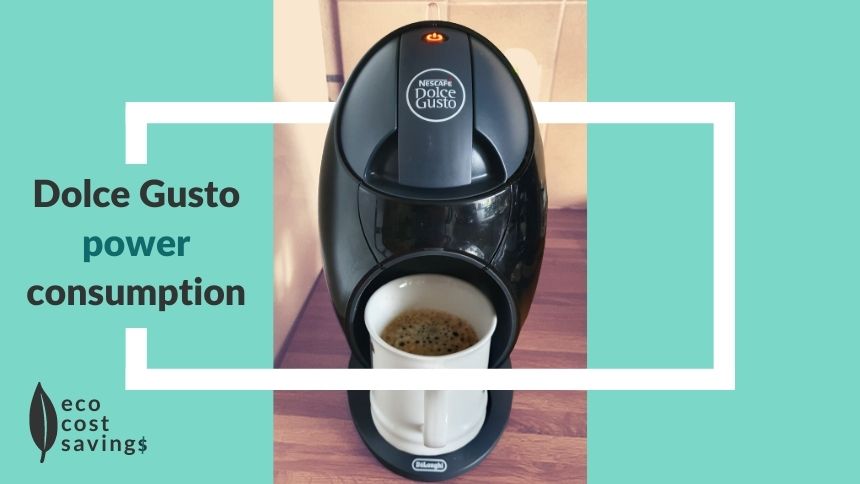Last updated: January 29, 2024.
Every wonder what the electricity cost of a coffee is from a Dolce Gusto? I did. Get a breakdown of the power consumption and electricity cost per cup below.
After some research and energy monitoring, here’s what I found.
Dolce Gusto users can expect to consume 0.03kWh of electricity per cup. In the US, on average this works out at .0045 cents in electricity. While in the UK, it costs .0057p on average per cup.
Continue reading to get a breakdown of the power consumed, see how the electricity costs compare to boiling an electric kettle and get 3 simple tips that will reduce your Dolce Gusto electricity costs.

Dolce Gusto power consumption
The power consumption of a Dolce Gusto will depend on the model. However, after reviewing the specifications available here, chances are your machine wattage is 1,500.
The vast majority of Dolce Gusto coffee machines have a 1,500W power rating.
Coffee machines don’t consume electricity at their maximum rating at all times. Using Amazon’s #1 Best Seller in “Single Serve Coffee Machines”, the Dolce Gusto Jovia, and my smart plug / energy monitor, the below is a breakdown of the actual power consumption for the different modes, along with the total power consumed.
| Mode | Power Consumption | More details |
| Heating the element | 1,360W | On average, 1,360W was consumed when I powered the coffee machine on – this is when the element was heating to the set temperature. |
| Dispensing coffee | 1,422W | During dispensing, I recorded an average of 1,422W. The combination of heating and dispensing the coffee results in this higher consumption. The highest wattage recorded was 1,447W, slightly lower than the max power rating of 1,500W. |
| Idle | 42W | 42W was consumed on average when the coffee machine was completely idle. This excludes the times when the device heated while idle. |
| Heating while idle | 275W | To keep the element hot enough to pour another coffee during idle, the device consumes approx. 275W temporarily, then drops to 42W again. This occurs 6 times in total over the 5 minutes it takes for the device to automatically power off. |
| Off but plugged in | 40W | The device continued to consume electricity when powered off but still plugged in. |
In total, to dispense 1 coffee and remain on for 5 minutes until auto power-off, the device consumed 0.03kWh of electricity.
Dolce Gusto electricity cost per cup
Now that we know the total power consumed, 0.03kWh, and using the average cost per kWh, we can easily work out the electricity cost per cup.
On average, in the US, it costs .0045 cents in electricity per cup.
In the UK, on average, it costs .0057p in electricity per cup from a Dolce Gusto coffee machine.
This assumes that you’re relying on the automatic power-off feature and that you plugged in your appliance just before use and unplugged when the automatic power-off feature activated.
3 simple tips to reduce your Dolce Gusto electricity costs
- Plug and unplug. Only plug in your device when you’re using it and make sure to unplug straight after. On average, the appliance consumed 40W of electricity while powered off but still plugged in.
- Don’t rely on the automatic power-off feature. Heating the device’s element is what consumes most electricity. When idle, the element heats up 6 times before automatically powering off. So if you don’t intend to pour another cup, be sure to unplug immediately.
- If you intend to pour another cup, do so straight after you pour your first cup. Reducing the amount of times heating is required will reduce your electricity consumption.
Dolce Gusto vs electric kettle
The average electric kettle consumes .073kWh of electricity. This is over twice as much as Dolce Gusto. And this is reflected in electricity costs.
It costs over twice as much to boil a kettle compared to using a Dolce Gusto. However, a kettle can pour more cups.
Get more details about electric kettle running costs, including 7 tips to keep your cost low.
Don’t miss
See how Dolce Gusto compares to other coffee makers here.
And don’t miss this 6 Quick Wins Cheat Sheet that’ll help you reduce your electricity bills and carbon footprint quickly and easily:
-
Coffee Maker Wattage & Efficiency [Top 117 Compared | 2024]
See the most energy efficient coffee makers, running costs & the average coffee maker wattage based on 117 of the top selling machines. Plus, get 5 cost saving tips here.
-
Dolce Gusto power consumption and electricity cost per cup
Every wonder what the electricity cost of a coffee is from a Dolce Gusto? I did. Get a breakdown of the power consumption and electricity cost per cup here.
-
Toaster Wattage 2024 [Lowest W | 226+ Studied | Cost P/Use]
How many watts does a toaster use, & which is the lowest wattage toaster? Find out here, based on enery tests, & a 226+ toaster wattage study. Plus, see the cost per use, hr & more.
James F (not to be confused with ECS co-founder James) is our lead author, content & website manager. He has a BSc. in Digital Marketing, and a Diploma in IT. He became a qualified electrician while studying electrical engineering part-time.
From wind and solar photovoltaic installers, James F worked with many certified energy practitioners and energy consultants before joining the core ECS team. He also helped build the most downloaded energy saving app while working with a leading utility company.
Read more about James F or connect directly on LinkedIn, here.


![Coffee Maker Wattage & Efficiency [Top 117 Compared | 2024]](https://ecocostsavings.com/wp-content/uploads/2021/07/coffee-maker-wattage.jpg)
![Toaster Wattage 2024 [Lowest W | 226+ Studied | Cost P/Use]](https://ecocostsavings.com/wp-content/uploads/2022/10/toaster-wattage.jpg)